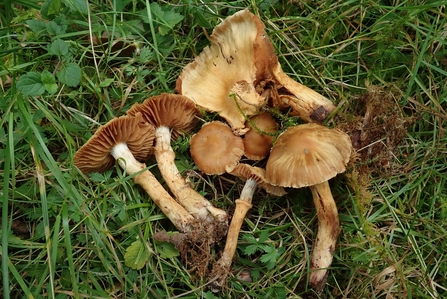
Cortinarius hinnuleoarmillatus found at Rushbeds Wood by Penny Cullington
Rhodocybe fumanellii found at Rushbeds Wood by Penny Cullington

Cortinarius hinnuleoarmillatus found at Rushbeds Wood by Penny Cullington
The Bucks Fungus Group (BFG) has made a good many visits to Rushbeds Wood since 1999 when the group was formed, and many interesting species have been recorded here.
Autumn 2020 has proved to be exceptional for fungal fruiting in the county and it’s ironic that, though thanks to Covid 19 BFG’s activities have been on hold, private visits have been going on apace all over the county and our members have been contributing to an online photographic record of Bucks finds which, as I write in mid-November, stands at well over 450 species.
I’ve made quite a few personal visits to Rushbeds this autumn, one of which was quite amazingly rewarding. Whilst wandering the path leading west from the central information board (the one that covers the local bat species), I found two species of fungi which were unfamiliar to me – this in itself is not unusual, there being so many thousands of different species.
What was baffling was the fact that once I examined them in detail using a microscope at home with reference to specialist books, keys, etc, neither of them conformed to known British species within their particular genera.
The first was a species of Cortinarius (Webcap) growing in longish grass beside the path near willow and birch. After consultation with Cortinarius gurus Geoffrey Kibby and Mario Tortelli we decided between us that this might well be C. hinnuleoarmillatus, a species not yet known in the UK but considered more than likely to be here.
Cortinarius is an enormous and tricky genus, still in need of unravelling and, consequently, quite often overlooked by British mycologists, hence discovering something not previously recorded here is in fact not as exceptional as it might at first appear – but still exciting, nonetheless!
The species name refers to its similarity to C. hinnuleus, having very widely spaced gills, and also to C. armillatus, having orange to rusty bands on the stem – both distinctive features clearly visible in the photos.

Cortinarius hinnuleoarmillatus found at Rushbeds Wood by Penny Cullington
Wandering on at Rushbeds I then spotted some large brown caps on a pile of mossy ash logs just off the path. Out came the camera again because on closer inspection I was confounded as to genus, let alone species, for these beauties.
However, at home they obligingly dropped a thick pinkish sporeprint overnight which put me straight onto the genus. Not many genera of mushrooms have pink spores, and of those that do a couple have gills which are free of the stem and one has uniquely shaped spores. My collection had neither of these features which left me with the unusual genus of Rhodocybe (Pinkgill).
One problem solved, then, but a larger problem remained because this collection clearly didn’t match any of the species described in available literature, let alone species known to be British. Geoffrey Kibby suggested that new Rhodocybe species were being discovered in Europe with the aid of DNA sequencing and that maybe mine was one of these.

Rhodocybe fumanellii found at Rushbeds Wood by Penny Cullington

Rhodocybe fumanellii found at Rushbeds Wood by Penny Cullington
Samples of both the Cortinarius and Rhodocybe collections from Rushbeds have now been sequenced and their identity confirmed. Rhodocybe fumanellii was first described from Italy in 2018 where there have apparently been a further handful of records since. Cortinarius hinnuleoarmillatus was first described in 1989.
It now remains to be seen whether these two interesting species are really rare in Britain or whether they’ve been lurking here unnoticed for years, maybe centuries!
That for me is part of the fascination of studying mycology: one never knows what’s round the next corner and these extraordinary organisms are so unpredictable and keep us guessing. There is so much still to discover and it’s a science one can enjoy whatever ones level of expertise.
If you’d like to learn more about local fungi, try the BFG website, and to see what we’ve been up to this autumn click here.
Penny Cullington - BFG Secretary